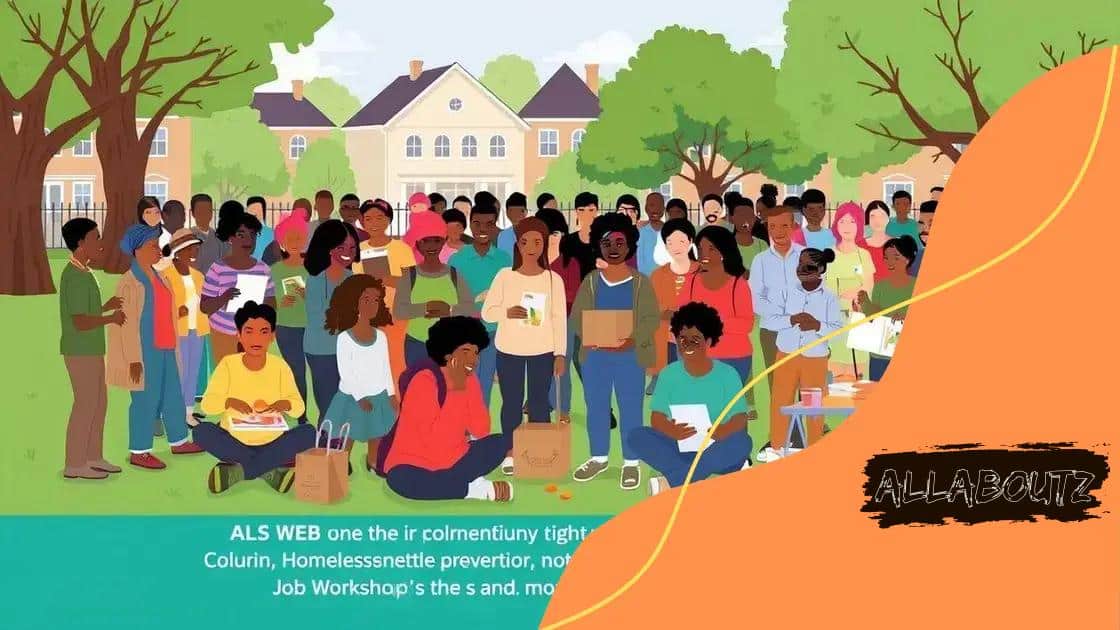Homelessness prevention strategies that really work

Homelessness prevention strategies are key approaches that include housing-first initiatives, community support, and effective measurement of success to ensure individuals have stable housing and necessary resources.
Homelessness prevention strategies and initiatives are crucial in tackling one of society’s most pressing issues. By understanding effective measures, communities can create sustainable solutions. Let’s dive into what works.
Understanding the causes of homelessness
Understanding the causes of homelessness is vital for developing effective prevention strategies. Various factors contribute to this complex issue. Identifying these underlying causes helps communities design better solutions.
Many individuals become homeless due to a sudden loss of income. This might happen after job loss, medical emergencies, or family crises. Without financial stability, it can be challenging to maintain housing. Additionally, affordable housing shortages also play a significant role in causing homelessness.
The impact of mental health and addiction
Mental health issues and substance abuse are often linked to homelessness. People struggling with these challenges may find it difficult to secure and maintain employment. Thus, understanding the interconnection between these factors is essential for targeted interventions.
- Access to treatment programs is crucial.
- Supportive housing options can help.
- Community awareness is necessary for reducing stigma.
Social isolation further complicates matters. Many homeless individuals lack a support network, making it harder for them to find resources or assistance. Outreach programs can bridge this gap by connecting people with services they need.
The role of systemic factors
Systemic factors also contribute to homelessness. Economic circumstances, such as rising costs of living and stagnant wages, exacerbate the issue. Legal issues, discrimination, and lack of access to education can similarly hinder an individual’s ability to secure stable housing. Comprehensive solutions must address these systemic barriers to effectively combat homelessness.
Effective housing-first strategies
Effective housing-first strategies focus on providing stable housing as the first step to addressing homelessness. This model prioritizes putting individuals into permanent housing without preconditions, such as sobriety or employment.
Research shows that when people have a place to live, they are more likely to improve their overall health and stability. In fact, stable housing often serves as a platform for individuals to engage more fully with support services, such as job training and mental health counseling.
The benefits of the housing-first approach
The benefits of these strategies are clear. They increase housing stability, reduce the use of emergency services, and are often more cost-effective than traditional models. For many, the security of having a home allows them to focus on personal goals.
- Improved mental health outcomes.
- Higher rates of employment.
- Decreased involvement with law enforcement.
Moreover, community involvement plays a crucial role in the success of housing-first initiatives. Engaging local businesses and residents fosters a supportive environment where those in need feel valued. This approach also helps reduce stigma surrounding homeless individuals, promoting inclusivity and understanding.
Implementing housing-first strategies
Implementing housing-first strategies requires collaboration among various stakeholders. Nonprofits, government agencies, and community organizations must work together to provide the necessary resources. Space can be found in existing affordable housing structures, and funding can come from government grants or private donations.
By focusing on the immediate need for housing, these initiatives can help break the cycle of homelessness. People can then pursue additional services at their own pace, leading to lasting change and community restoration. Understanding the significance of effective housing-first strategies is essential for building supportive communities and fostering an inclusive society.
Role of community support in prevention

The role of community support in preventing homelessness is crucial. When communities come together to help those in need, they create a safety net that can make a significant difference.
Community involvement builds connections among residents, which can lead to greater awareness of local challenges. When neighbors know each other, they can offer assistance and support. This network can help individuals find jobs, access health services, and secure stable housing.
Building a supportive environment
A strong sense of community fosters collaboration. Local organizations often work with businesses and residents to create programs that directly address homelessness. Together, they can provide resources such as food banks, job training, and mentorship opportunities.
- Community centers can serve as safe spaces for individuals.
- Volunteer programs allow residents to actively engage.
- Networking events can connect individuals with job opportunities.
Moreover, raising awareness about homelessness can reduce stigma associated with it. By sharing stories and educating others, communities can promote empathy and understanding. When people see others as part of their community, they are more likely to support initiatives that help those in need.
Collaboration with local agencies
Effective partnerships between community members and local agencies can streamline efforts to prevent homelessness. Agencies can offer training and resources while community members provide grassroots support. This combination ensures a comprehensive approach that addresses multiple aspects of homelessness.
When communities unite to support their members, they build resilience. This collaboration creates an environment where individuals feel valued and supported, helping to prevent homelessness before it begins. Community support is not just about providing resources; it’s about fostering a culture of kindness and understanding that enables everyone to thrive.
Innovative initiatives from around the world
Innovative initiatives from around the world show how different communities tackle homelessness. By learning from each other, we can adopt successful solutions that work effectively.
For example, in Finland, the housing-first strategy has made a significant impact. This approach prioritizes providing homes to individuals without conditions. This initiative has helped reduce the homeless population by offering stable housing and support services.
Global approaches to community engagement
In Canada, programs involve local communities in finding solutions. Many cities sponsor community forums to discuss homelessness. Residents are encouraged to share ideas and engage in local efforts. These initiatives empower individuals to take action and assist their neighbors.
- Community resource fairs provide vital information.
- Job fairs help connect individuals with employment.
- Educational workshops raise awareness of homelessness issues.
Another example can be seen in the United States, where cities like Salt Lake City implemented a similar housing-first model. This initiative not only provides shelter but also connects individuals to mental health and job training programs, addressing root causes of homelessness.
Creative solutions in Asia and Europe
Over in Japan, unique solutions are emerging as well. Certain cities have developed “migrant cafes.” These spaces provide employment opportunities for homeless individuals while offering them a safe environment to gather. This approach helps foster community ties and enables individuals to regain their self-sufficiency.
In the UK, the concept of pop-up villages has gained popularity. These temporary communities provide a place for homeless individuals to live while they receive support to transition to permanent housing. This innovative idea demonstrates how flexible solutions can adapt to the needs of the population.
Innovative initiatives from different regions highlight the importance of creativity and collaboration in addressing homelessness. By learning from each other, communities can develop effective strategies to support their citizens.
Measuring success in prevention efforts
Measuring success in prevention efforts is vital for improving strategies to combat homelessness. Effective metrics help identify what works best and guide future initiatives.
One key indicator of success is the reduction in homelessness rates over time. This statistic shows the overall impact of prevention efforts and highlights effective programs. Tracking how many individuals are transitioned from homelessness to stable housing provides insight into what methods are most effective.
Data collection methods
Data collection methods vary, but common approaches include surveys and interviews with individuals experiencing homelessness. Gathering feedback helps organizations understand challenges and obstacles faced by people in need.
- Surveys can assess the quality of services provided.
- Interviews offer personal insights into lived experiences.
- Regular data reviews ensure that strategies remain relevant.
Another important measure is the length of time individuals experience homelessness. Shorter durations indicate effective interventions that can lead to fewer people experiencing long-term homelessness. Analyzing trends in housing stability among formerly homeless individuals also reflects the success of support services.
Community involvement and feedback
Community involvement plays a crucial role in measuring success. Engaging local stakeholders can provide valuable perspectives on what changes are needed. Regular community forums encourage collaboration and ensure stakeholders are invested in the process.
Using metrics like job placement rates and access to healthcare further strengthens understanding of success. Programs that assist individuals in finding employment or health services can directly impact homelessness outcomes.
By focusing on these metrics, communities can continually adapt and improve their prevention efforts. Measuring success is an ongoing process that enables collaboration and innovation, ultimately leading to more effective solutions for homelessness.
FAQ – Frequently Asked Questions about Homelessness Prevention Strategies
What are housing-first strategies?
Housing-first strategies aim to provide stable housing to individuals without preconditions, significantly reducing homelessness rates.
How can community support help in preventing homelessness?
Community support fosters connections among residents, enabling them to offer assistance, share resources, and create a supportive environment.
Why is measuring success important in homelessness prevention efforts?
Measuring success helps communities identify effective strategies and adapt their initiatives based on clear metrics and feedback.
What are some innovative initiatives globally addressing homelessness?
Innovative initiatives include housing-first programs in Finland, community forums in Canada, and pop-up villages in the UK that provide temporary housing solutions.





